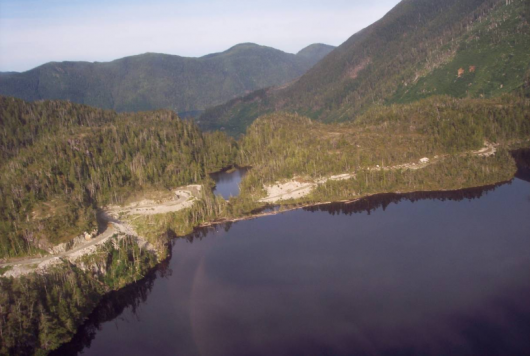
Aerial view of Rich’s Pond and Lake Mellen on Prince of Wales Island, part of the area in the Reynolds Creek hydro project.
A new hydro power project on Prince of Wales Island has been approved for a huge loan, bringing it one hurdle closer to completion.
Alaska Energy Authority in June approved a $20 million loan to Haida Energy Inc. for construction of the Reynolds Creek hydro project on Prince of Wales Island.
Reynolds Creek is about 10 miles east of Hydaburg. The project, a five megawatt plant, could allow nearly all of the island’s residents to use almost exclusively hydro power. Right now, residents depend on diesel-generated power during some parts of the year, which increases energy prices.
“The residents of Prince of Wales already have the benefit of a couple of hydro projects that have been built,” said Gene Therriault, a deputy director at the AEA who had a vote in moving the loan toward approval. “But on a seasonal basis, there are times when they run out of that hydro power. And so adding this new power in appeared to be very good thing for them to do, it will help long term with the cost and the stability of power for the region.”
The Reynolds Creek project is the work of Haida Energy Inc., a joint venture of the Haida Corporation and Alaska Power and Telephone Company.
Therriault says the division of the AEA that approved this loan, the Power Project Fund, has a goal of lowering energy costs for people in remote areas of Alaska.
According to AP&T, the Reynolds Creek project could cut energy costs for Prince of Wales Island residents by more than half.
The AEA loan of $20 million funds most of the estimated $28 million cost of the project. The loan has a 3.78 percent interest rate with a 7-year interest-free grace period.
Therriault said once the project is complete, the island will be able to produce even more energy than it currently needs.
“But it’s always sort of a question…a little bit of a chicken and an egg,” he said. “Do you have electric demand that you see out there in the future that is certain and so you build the capacity to serve that load? Or do you build the electric load in the anticipation of being able to attract that economic activity?”
The AEA and Haida Energy hope increasing the electric load will, in turn, increase economic growth on the island.
The next step? In order to close the loan, Haida Energy must get approval from the Regulatory Commission of Alaska for a power sales agreement.
They hope to complete the Reynolds Creek project by June 2016.






